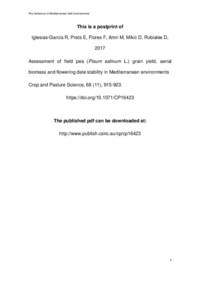Assessment of field pea (Pisum sativum L.) grain yield, aerial biomass and flowering date stability in Mediterranean environments

Authors:
Mediterranean environments are of most interest to study pea adaptability to terminal drought conditions especially in the current context of global climate change. In our work we have tested nine pea cultivars in five South European and North African locations, characterised by different agro climatic conditions within the Mediterranean climate. Data were processed through the additive main effects and multiplicative interaction analysis. Grain yield, aboveground biomass and flowering date were assessed within each mega-environment with parametric and non-parametric methods, establishing ranks for the genotypes within each condition attending to their stability parameters and mean values. The field analysis revealed HR1 as a wide-adapted genotype, whereas others such as Desso showed the best adaptation in South Mediterranean areas. Our results also highlighted the potential interest of these genotypes and others (i.e. Messire and ZP108) in breeding programs and further studies on drought tolerance.
